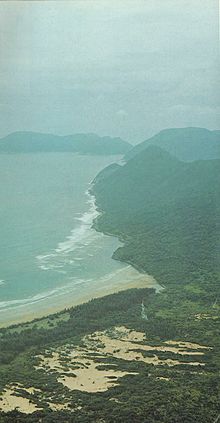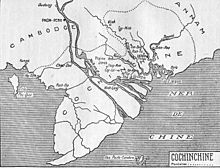- Côn Sơn Island
-
Coordinates: 8°41′35″N 106°36′34″E / 8.69306°N 106.60944°E
Côn Sơn Island (Vietnamese Côn Sơn) is the largest island of the Côn Đảo archipelago, off the coast of southern Vietnam.[1] The island is also known after its Malay name as Pulo Condore[2] (pulo as a corruption of pulau, meaning "island"), while its French variant Poulo Condor was well-known during the times of French Indochina.
Contents
Early modern era
In 1702, the British East India Company founded a settlement on the island of Poulo Condor off the south coast of southern Vietnam, and in 1705 the garrison and settlement were destroyed.
In 1787, through the Treaty of Versailles, Nguyễn Ánh (the future Emperor Gia Long) promised to cede Poulo Condor to the French. In exchange Louis XVI promised to help Nguyễn Ánh to regain the throne, by supplying 1,650 troops (1,200 Kaffir troops, 200 artillery men and 250 black soldiers) on four frigates.[3][4]
In 1861, the French colonial government established a prison on the island to house political prisoners. In 1954, it was turned over to the South Vietnamese government, who continued to use it for the same purpose. Notable prisoners held at Côn Sơn in the 1930s included Phạm Văn Đồng and Lê Ðức Thọ.[1] Not far from the prison is Hang Duong Cemetery, where some of the prisoners were buried.
“Tiger cages”
During the Vietnam War, prisoners who had been held at the prison in the 1960s said they were abused and tortured. In July 1970, two U.S. Congressional representatives, Augustus Hawkins and William Anderson, visited the prison. They were accompanied by Tom Harkin (then an aide), translator Don Luce, and USAID Office of Public Safety Director Frank Walton. When the delegation arrived at the prison, they departed from the planned tour, guided by a map drawn by a former detainee. The map led to the door of a building, which was opened from the inside by a guard when he heard the people outside the door talking. Inside they found prisoners were being shackled within cramped “tiger cages”. Prisoners began crying out for water when the delegation walked in. They had sores and bruises, and some were mutilated. Harkin took photos of the scene. The photos were published in Life magazine on July 17, 1970.
The prison on Côn Sơn Island was closed in 1975, when North Vietnam (now unified as Vietnam) toppled the South Vietnamese government, in the wake of the withdrawal by the United States and its allies (South Korea, Australia) from the Vietnam War.
Along with the earlier disclosure of the Mỹ Lai massacre, and the later disclosure of the Pentagon Papers, the revelation of the conditions and purpose of Côn Sơn Island prison led more Americans to believe that supporting the South Vietnamese government was improper, and that they should oppose the war.
Recreations of tiger cages can be seen today at the War Remnants Museum in Ho Chi Minh City.
LORAN Station Con Son
At the request of Secretary of Defense Robert McNamara, the U.S. Coast Guard started pre-construction plans for a chain of Loran-C radio stations to serve southeast Asia 15 January 1966 in support of Operation Tight Reign during the Vietnam War.[5][6] The actual construction of Station Con Son began during April with the delivery of construction materials by USCGC Nettle (WAK-169) and award of construction contracts to Morrison-Knudsen Corp. and Brown and Root Company.[7]. Station Con Son was one of five stations in the southeast Asia chain and was designated SH-3 Yankee. It consisted of a 625 foot (191 m) tower, transmitter equipment buildings, fuel tanks, generators and barracks for personnel located on the north end of Con Son Island.[1] [6] The personnel complement for the station was two officers and 23 enlisted men. After commissioning 2 September 1966 the station began the testing phase of operations and the five station chain was fully operational by 0400 28 October,[8] just nine months after the initial request from the Department of Defense.[9][10] The station provided, along with its sister stations in the chain, signals that allowed aircraft and ships to receive accurate all-weather positioning data for navigation purposes. During January 1973 the operation of the station was turned over to civilian contractors who were responsible to the Coast Guard for all functions of the station. The Coast Guard continued to supply logistical and technical support on an as needed basis[11] When the fall of the South Vietnamese government was imminent, Station Con Son was directed to stay on the air until the last possible minute to provide navigation signals to aircraft and ships fleeing South Vietnam. Station Con Son stayed on the air until 1246 local time 29 April 1975 after the crew oversped the generators and damaged critical pieces of electronic gear.[12]
Notes
- Footnotes
- Citations
- ^ a b c Kelley, p 5-116
- ^ "Pulo Condore Group, Vietnam". National Geospatial-Intelligence Agency. http://www.geographic.org/geographic_names/name.php?uni=-4954156&fid=6654&c=vietnam. Retrieved 25 August 2011.
- ^ Chapuis, p 175
- ^ Kamm, p 86
- ^ Larzelere, p 193
- ^ a b Scotti, p 91
- ^ Larzelere, P 200
- ^ Scotti, p 94
- ^ Johnson, p 337
- ^ Larzelere, p 203
- ^ Larzelere, p 270
- ^ Larzelere, p 279
References cited
- Chapuis, Oscar M. (1995). History of Vietnam:From Hong Bang to Tu Duc. Greenwood Press. ISBN 9780313296222.
- Johnson, Robert Erwin (1987). Guardians of the Sea: History of the United States Coast Guard, 1915 to the Present. Naval Institute Press, Annapolis. ISBN 978-0-87021-720-3.
- Kamm, Henry (2002). Dragon Ascending. Arcade Books. ISBN 9781611450781.
- Kelley, Michael P. (2002). Where We Were in Vietnam. Hellgate Press, Central Point, OR. ISBN 978-1-55571-625-7.
- Larzelere, Alex (1997). The Coast Guard at War, Vietnam, 1965-1975. Naval Institute Press, Annapolis. ISBN 978-1-55750-529-3.
- Scotti, Paul C. (2000). Coast Guard Action in Vietnam:Stories of Those Who Served. Hellgate Press, Central Point, OR. ISBN 978-1-55571-528-1.
See also
Further reading
- Brown, Holmes and Don Luce (1973). Hostages of War; Saigon's Political Prisoners. Indochina Mobile Education Project.
- Valentine, Douglas (2000). The Phoenix Program. Backinprint.com. ISBN 9780595007387.
External links
- The Con Dao Archipelago
- The Tiger Cages of Con Son
- THEN THE AMERICANS CAME - Mrs. Truong My Hoa
- Con Son Prison Photo Gallery by Matthew Herschmann at pbase.com
- VisitCondao.com
Bold text
Categories:- Islands of Vietnam
- Defunct prisons in Vietnam
- War crimes in Vietnam
- Vietnam War prisoner of war camps
- Vietnam War sites
- Ba Ria-Vung Tau Province
- Torture in Vietnam
Wikimedia Foundation. 2010.


